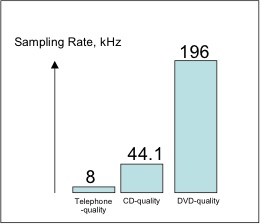Wideband Hits the Mark
Quality audio. What's the big deal?
The technique of IP Telephony operation is a three step process – capture, transmission and re-assembly – and is the same basic mechanism that Alexander Graham Bell first invented in the 1870s.
Today, in modern IP PBXs or consumer VoIP services, the capture mechanism is a process of audio sampling, converting the resulting waveform into a digital signal and inserting this digital representation into an Ethernet frame and then constituting an IP packet.
The sample rate, as measured in Hertz (cycles per second) is a function of the audio quality. Higher sampling imbeds more information into the transmission, consumes more bandwidth, and delivers more satisfying audio experience. That's because the harmonics of a sound are fuller and more natural when sampled at a higher rate. As the figure shows, the phone company's sample rate of 8 kHz has been superceded by commercial music technologies such as CD and DVD. The DVD signal is particularly rich since it delivers multiple channels – think of Dolby 5.1 which delivers 5 channels of audio front left, front right, front center, rear left, rear right and the sub-woofer for low frequency outputs – to give users a total audio experience.
This richness in audio quality is the basis for many a home entertainment room's electronic design. Although quite appropriate for experiencing media-rich movies, it may not be the appropriate audio experience for a business conversation.
Years ago, the scientists at Bell Labs, determined that the appropriate tradeoff of audio quality of human conversations versus bandwidth consumed, was 8 kHz. Higher sample rates offer higher quality audio, a richer media, but consume much more bandwidth. Lower sample rates consumed less bandwidth, but generated low satisfaction with audio quality.
This post has already been read 0 times!
Edit
